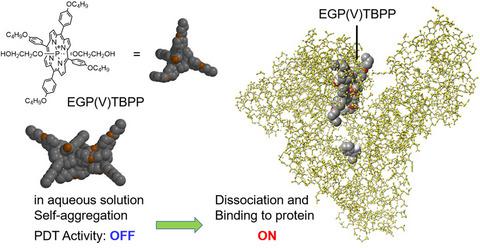当前位置:
X-MOL 学术
›
Photochem. Photobiol.
›
论文详情
Our official English website, www.x-mol.net, welcomes your
feedback! (Note: you will need to create a separate account there.)
Photosensitized Protein Damage by DiethyleneglycoxyP(V)tetrakis(p-n-butoxyphenyl)porphyrin Through Electron Transfer: Activity Control Through Self-aggregation and Dissociation
Photochemistry and Photobiology ( IF 2.6 ) Pub Date : 2021-09-13 , DOI: 10.1111/php.13517 Kazutaka Hirakawa 1, 2, 3 , Mami Yoshida 3 , Toru Hirano 4 , Jotaro Nakazaki 5 , Hiroshi Segawa 5
Photochemistry and Photobiology ( IF 2.6 ) Pub Date : 2021-09-13 , DOI: 10.1111/php.13517 Kazutaka Hirakawa 1, 2, 3 , Mami Yoshida 3 , Toru Hirano 4 , Jotaro Nakazaki 5 , Hiroshi Segawa 5
Affiliation

|
DiethyleneglycoxyP(V)tetrakis(p-n-butoxyphenyl)porphyrin (EGP(V)TBPP) forms a self-aggregation in an aqueous solution, and the photoexcited state of this molecule was effectively deactivated. Association with human serum albumin (HSA), a water-soluble protein, causes dissociation of the self-aggregation, resulting in recovery of the photosensitizer activity of EGP(V)TBPP. Under visible light irradiation, EGP(V)TBPP photosensitized HSA oxidation. The photosensitized singlet oxygen–generating activity of EGP(V)TBPP was confirmed by near-infrared emission measurement. A singlet oxygen quencher, sodium azide, partially inhibited the HSA photodamage; however, the quenching effect was estimated to be 57%. Another 43% of the HSA photodamage could be explained by the electron transfer mechanism. The redox potential of EGP(V)TBPP and the calculated Gibbs energy of electron transfer from tryptophan to photoexcited EGP(V)TBPP demonstrated the possibility of HSA oxidation through electron extraction. Fluorescence lifetime measurements of EGP(V)TBPP verified the electron transfer from HSA. The photosensitizer activity of EGP(V)TBPP can be controlled through an association with biomolecules, such as protein, and the electron transfer–mediated biomolecule photooxidation plays an important role in photodynamic therapy under hypoxia.
中文翻译:

DiethyleneglycoxyP(V)tetrakis(pn-butoxyphenyl)porphyrin 通过电子转移引起的光敏蛋白损伤:通过自聚集和解离的活性控制
二乙撑氧基P(V)tetrakis( p - n-丁氧基苯基)卟啉(EGP(V)TBPP)在水溶液中形成自聚集体,该分子的光激发态被有效失活。与水溶性蛋白质人血清白蛋白 (HSA) 结合,导致自聚集解离,导致 EGP(V)TBPP 的光敏剂活性恢复。在可见光照射下,EGP(V)TBPP光敏化HSA。通过近红外发射测量证实了 EGP(V)TBPP 的光敏单线态氧生成活性。单线态氧猝灭剂叠氮化钠部分抑制了 HSA 光损伤;然而,淬火效应估计为 57%。另外 43% 的 HSA 光损伤可以通过电子转移机制来解释。EGP(V)TBPP 的氧化还原电位和计算的从色氨酸到光激发的 EGP(V)TBPP 的电子转移吉布斯能量证明了通过电子提取进行 HSA 氧化的可能性。EGP(V)TBPP 的荧光寿命测量验证了来自 HSA 的电子转移。EGP(V)TBPP的光敏剂活性可以通过与蛋白质等生物分子的结合来控制,电子转移介导的生物分子光氧化在缺氧条件下的光动力治疗中发挥着重要作用。
更新日期:2021-09-13
中文翻译:

DiethyleneglycoxyP(V)tetrakis(pn-butoxyphenyl)porphyrin 通过电子转移引起的光敏蛋白损伤:通过自聚集和解离的活性控制
二乙撑氧基P(V)tetrakis( p - n-丁氧基苯基)卟啉(EGP(V)TBPP)在水溶液中形成自聚集体,该分子的光激发态被有效失活。与水溶性蛋白质人血清白蛋白 (HSA) 结合,导致自聚集解离,导致 EGP(V)TBPP 的光敏剂活性恢复。在可见光照射下,EGP(V)TBPP光敏化HSA。通过近红外发射测量证实了 EGP(V)TBPP 的光敏单线态氧生成活性。单线态氧猝灭剂叠氮化钠部分抑制了 HSA 光损伤;然而,淬火效应估计为 57%。另外 43% 的 HSA 光损伤可以通过电子转移机制来解释。EGP(V)TBPP 的氧化还原电位和计算的从色氨酸到光激发的 EGP(V)TBPP 的电子转移吉布斯能量证明了通过电子提取进行 HSA 氧化的可能性。EGP(V)TBPP 的荧光寿命测量验证了来自 HSA 的电子转移。EGP(V)TBPP的光敏剂活性可以通过与蛋白质等生物分子的结合来控制,电子转移介导的生物分子光氧化在缺氧条件下的光动力治疗中发挥着重要作用。











































 京公网安备 11010802027423号
京公网安备 11010802027423号